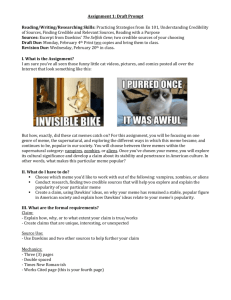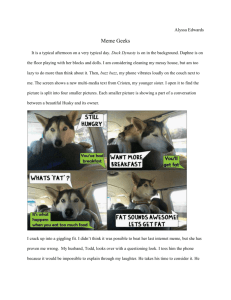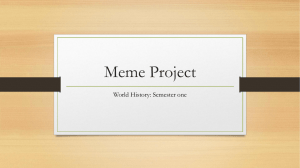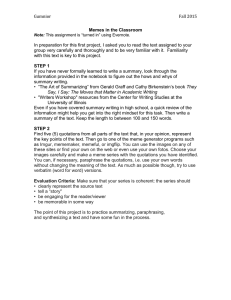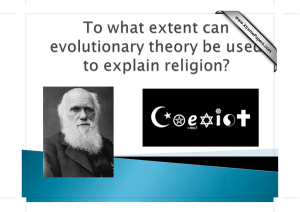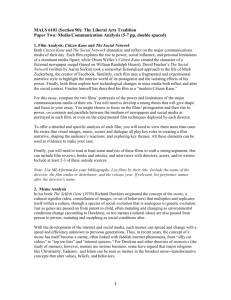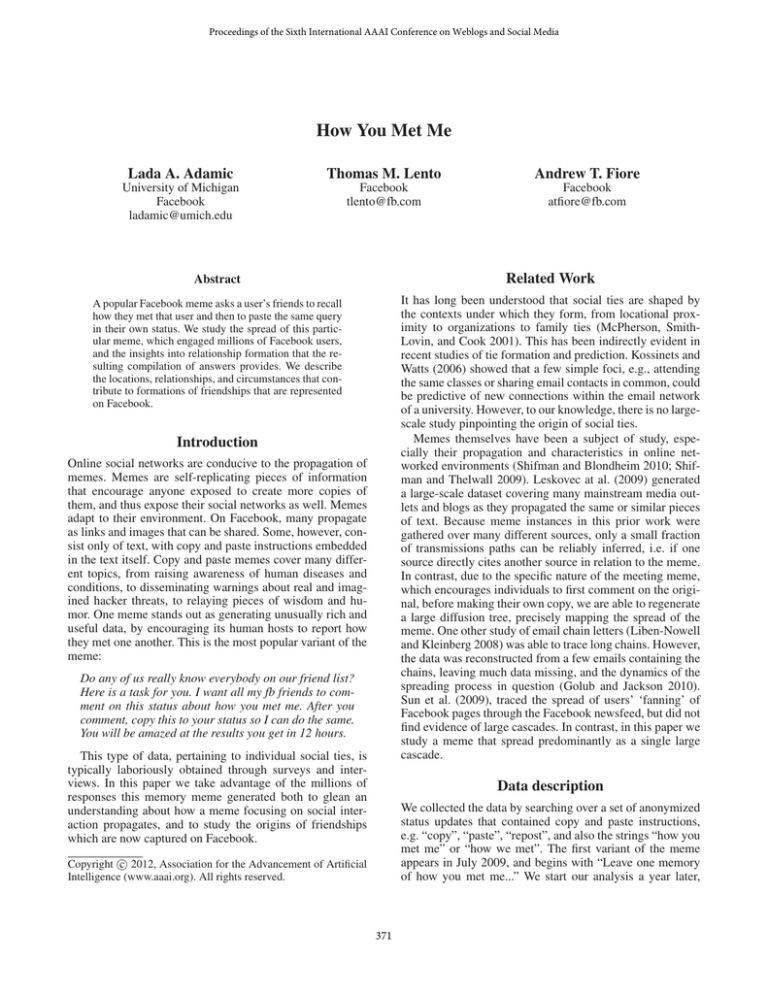
Proceedings of the Sixth International AAAI Conference on Weblogs and Social Media
How You Met Me
Lada A. Adamic
Thomas M. Lento
Andrew T. Fiore
University of Michigan
Facebook
ladamic@umich.edu
Facebook
tlento@fb.com
Facebook
atfiore@fb.com
Abstract
Related Work
A popular Facebook meme asks a user’s friends to recall
how they met that user and then to paste the same query
in their own status. We study the spread of this particular meme, which engaged millions of Facebook users,
and the insights into relationship formation that the resulting compilation of answers provides. We describe
the locations, relationships, and circumstances that contribute to formations of friendships that are represented
on Facebook.
It has long been understood that social ties are shaped by
the contexts under which they form, from locational proximity to organizations to family ties (McPherson, SmithLovin, and Cook 2001). This has been indirectly evident in
recent studies of tie formation and prediction. Kossinets and
Watts (2006) showed that a few simple foci, e.g., attending
the same classes or sharing email contacts in common, could
be predictive of new connections within the email network
of a university. However, to our knowledge, there is no largescale study pinpointing the origin of social ties.
Memes themselves have been a subject of study, especially their propagation and characteristics in online networked environments (Shifman and Blondheim 2010; Shifman and Thelwall 2009). Leskovec at al. (2009) generated
a large-scale dataset covering many mainstream media outlets and blogs as they propagated the same or similar pieces
of text. Because meme instances in this prior work were
gathered over many different sources, only a small fraction
of transmissions paths can be reliably inferred, i.e. if one
source directly cites another source in relation to the meme.
In contrast, due to the specific nature of the meeting meme,
which encourages individuals to first comment on the original, before making their own copy, we are able to regenerate
a large diffusion tree, precisely mapping the spread of the
meme. One other study of email chain letters (Liben-Nowell
and Kleinberg 2008) was able to trace long chains. However,
the data was reconstructed from a few emails containing the
chains, leaving much data missing, and the dynamics of the
spreading process in question (Golub and Jackson 2010).
Sun et al. (2009), traced the spread of users’ ‘fanning’ of
Facebook pages through the Facebook newsfeed, but did not
find evidence of large cascades. In contrast, in this paper we
study a meme that spread predominantly as a single large
cascade.
Introduction
Online social networks are conducive to the propagation of
memes. Memes are self-replicating pieces of information
that encourage anyone exposed to create more copies of
them, and thus expose their social networks as well. Memes
adapt to their environment. On Facebook, many propagate
as links and images that can be shared. Some, however, consist only of text, with copy and paste instructions embedded
in the text itself. Copy and paste memes cover many different topics, from raising awareness of human diseases and
conditions, to disseminating warnings about real and imagined hacker threats, to relaying pieces of wisdom and humor. One meme stands out as generating unusually rich and
useful data, by encouraging its human hosts to report how
they met one another. This is the most popular variant of the
meme:
Do any of us really know everybody on our friend list?
Here is a task for you. I want all my fb friends to comment on this status about how you met me. After you
comment, copy this to your status so I can do the same.
You will be amazed at the results you get in 12 hours.
This type of data, pertaining to individual social ties, is
typically laboriously obtained through surveys and interviews. In this paper we take advantage of the millions of
responses this memory meme generated both to glean an
understanding about how a meme focusing on social interaction propagates, and to study the origins of friendships
which are now captured on Facebook.
Data description
We collected the data by searching over a set of anonymized
status updates that contained copy and paste instructions,
e.g. “copy”, “paste”, “repost”, and also the strings “how you
met me” or “how we met”. The first variant of the meme
appears in July 2009, and begins with “Leave one memory
of how you met me...” We start our analysis a year later,
c 2012, Association for the Advancement of Artificial
Copyright Intelligence (www.aaai.org). All rights reserved.
371
8e+05
0e+00
4e+05
popularity
10000
100
1
number of status udpates
0
200
400
600
800
day
1
2
5
10
20
50
100
500
Figure 3: Popularity of the meme over time.
number of individuals responding
Meme variants
Figure 1: The distribution of the number of repliers per post.
The main variants of the meme had four clauses that facilitated its spread. The first is the explicit copy and paste instruction without which the meme was unlikely to be viable.
The second is the challenge and task nature of the activity.
The meme raises doubt that the person reading it can remember how they met their friend, and then directly tasks the
reader with the action. The third clause places an obligation
of reciprocity on the reader: “after you comment, copy this
to your status so I can do the same”. The fourth promises
good results “You will be amazed at the results you get in 12
hours”.
Some variants apply further pressure: “Now that you’ve
read it, you must comment. DON’T CHEAT!!” but were not
as popular as the original. Some dropped the 12 hour clause,
or promised great results without a fixed time frame. Others
prefaced the meme with favorable reviews (“This is fun!”
or “This should be interesting...”).
By far the most popular variants, excluding the original
meme itself, twisted the meme around, asking friends to lie
about how they had met:
in July 2010, concluding in November 2011. A manual examination of the resulting set of high occurrence status updates showed that they were nearly all variants of the memory meme. We detected 2,570,182 posts of the meme, with
24,199,921 comments, excluding self-comments typically
posted by a user in response to someone recalling how they
had met them. Figure 1 shows the distribution of the number of unique repliers for each post that was commented on.
On average 7.5 distinct respondents commented on how they
met the user.
User demographics
I would like my Facebook friends to comment on this
status, sharing how you met me. But I want you to LIE.
That’s right, just make it up. After you comment, copy
this to your status, so I can do the same. I bet half won’t
read the instructions right!
0.030
Diffusion structure
0.010
0.020
The meme waxed and waned over a period of nearly 2 years,
experiencing a few dramatic flare-ups, as shown in Figure 3.
It is one of the most popular and long-lived Facebook status
update memes during this period. Because the popularity of
the meme showed such dramatic variation, and because it
was nearly extinct for weeks at a time, it is not immediately
obvious whether those engaged with the meme can be connected, or whether the meme spontaneously re-emerges as
individuals decide to task their networks with recalling how
they had met.
To trace the diffusion paths, we limited our analysis to
those who had posted the meme to their status, and omitting those who had commented on the meme, but had not
made the request of their own friends. We then time-ordered
0.000
proportion of users
The meme appealed primarily to women, with 79.7% of
posts being made by them. This is consistent with a sample of other copy-and-paste memes which averaged 73.3%
female. The age distribution is broad (see Figure 2), with an
average age of 34.5 ± 12.6 (excluding ages over 80, which
are unlikely to be honestly reported). Since we are examining just the English variant of the meme, English-speaking
countries are by far the most represented: (United States
70.1%, Great Britain 11.4%, Canada 5.8%, Australia 3.7%,
New Zealand 0.7%, South Africa 0.6%, Ireland 0.5%).
20
30
40
50
60
70
80
age
Figure 2: Age distribution of users propagating the meme.
372
the posts and comments, and identified the earliest post that
a user had commented on as the parent of that user’s node
in the diffusion tree. Tracing such ties in a breadth-first and
directed manner, we found the longest chain to be 82 steps
from root note to leaf node. We then recursively added all
comment-to-post interactions that connected to that chain,
and arrived at a giant component of 2,174,920 nodes, comprising over 84.4% of all the users we identified as having
posted the meme. The graph is relatively sparse. Someone
who had posted the meme had also commented on 2.3 posts
on average.
category
school
work
party
birth
church
neighbor
sport
home
hospital
student
Thus, even though the meme’s infection levels fell below
1000/day for weeks at a time, users participating in different
major outbreaks that were spaced far apart in time were connected to one another through long infection chains. The giant component spanned the very beginning of our collection
period (July 1, 2010) through the end (Nov. 19, 2011). It had
reached its maximal depth of 82 on August 10, 2011. The
disconnected components, the largest of which included 302
users, could have occurred for several reasons. A user may
have copied the meme into their own status without commenting on someone else’s first. Or a post may have been
deleted at a later point, leaving a gap in the chain. 4.9% of
all nodes in the graph had no parent node.
Table 1: Friendship formation foci
keyword
school, class, grade, freshman...
coworker, work, job, training...
wedding, funeral, party...
birth, born
church, choir, seminary...
lived in the same, neighbor, next door...
basketball, football, cheerleading
house, home, apartment...
hospital
my teacher, your teacher, my student
Origins of friendships
We analyzed the responses in the form of comments to
the meme in order to gain an understanding regarding the
origin of friendships. We used a series of simple regular
expressions to extract different forms of responses: locations, intermediaries, direct familial relationships, introductions through others, and one-word answers. We omitted responses to posts that contained the word “lie”, as we did
not want to include fabricated friendship starts. We also included just the first response of each commenter, as sometimes the asker replied to an initial response and spurred offtopic conversation. The data is naturally noisy, with some
friends launching into lengthy recollections, while others
were brief but did not stay to task. Some terms are also ambiguous, e.g. “orientation” can refer to an educational or a
work setting. Furthermore, many responses contained just
a single proper name, e.g. ”Kennedy” to denote Kennedy
High School, or Applebee’s, denoting either an employer or
a hangout where the first encounter took place.
Despite the noisy nature of the data, the large volume of
responses allows us to observe several patterns. A combination of regular expressions (excluding one-word responses)
matched 42.9% percent of the responses. Another 2.9% were
single word responses. Many of the unmatched responses
were a mix of unique stories (e.g. “I was just chillin’ waiting on a sibling to show up, and I got you!!!”, jokes (e.g.
“Do I know you lol”?), and non-response banter (e.g. “It’s
been so long ago I don’t remember!”).
Foci
A few simple terms, partially listed in Table 1, were used to
extract activity and geographic foci from 39.7% responses.
The relative proportions of responses are a product of both
the actual likelihood of meeting a friend in a specific environment and the keywords we used, although we tried to
include as many of the frequently occurring words as possible. For example, many responses listed employers rather
than mentioning the word “work” in their response. We observe that school is a popular milieu of friendship formation,
but that it drops off slightly in favor of work as a function of
age, suggesting an attrition in friends from school over time.
Most mentions of hospitals appeared to pertain birth events,
e.g. a mother telling her child that she met her at the hospital.
Figure 4: A brief portion of the diffusion of the meme. Nodes
are users who posted their meme as their Facebook status.
Edges are drawn between nodes if one user commented on
the meme post of another. The colors denote the time at
which the status update was posted, starting on the 6th of
July 2010 (red), and ending 9th July 2010 (blue). The meme
continued propagating past this point, eventually reaching
millions of users.
373
Although statistically significant (χ2 > 104 , p < 10−10 ),
gender effects in friendship foci were mild, with two exceptions. Men were 57% more likely to meet a friend through
sports than women, while women were 34% more likely
than men have befriended a neighbor.
Conclusion
In this short paper we presented the spread of and content
induced by a remarkable single meme. The meme reached
millions of individuals and propagated in long chains. The
responses it evoked from these individuals tell us that a
significant fraction of Facebook friendships originated at
school, even for individuals who have not been in school
for decades. Interestingly, we fail to find a gender effect in
introductions made through family: brothers are as likely to
have made introductions for women as their sisters. The data
is far richer than what this initial analysis has yielded, and
we plan to explore it further in future work.
The richness of the data calls for a more in depth study
of the properties of friendship formation. For example, the
results suggest that different types of shared attributes, such
as affiliations with schools and employers, can differ in their
ability to predict friendships for different periods in an individual’s life and may vary by gender. There may also be
some close ties, e.g. siblings and spouses, who play a disproportionate role in shaping individuals’ social networks
in ways that have not been studied on a large scale. There
is also the broader question of whether certain nodes in the
network literally play the role of connectors by initially introducing many friends to one another. All these questions
are interesting avenues for future work.
Connectors
0.00 0.05 0.10 0.15
fraction of responses
Responses listed individuals through whom the connection
had been made. We matched words such as thru, through,
dating, dated, married followed by words such as my, your,
our mutual as well as possessive words like “my” at the beginning of a comment. We recorded the next word that occurred, excluding adjectives. 4.2% of all responses were a
match. Many listed family members as being the ones who
made the introductions. The most frequent connectors were
siblings, with an expected symmetry in the replies. “My
brother” (1.6%) and “your brother” (1.4%) were the two
most common responses, followed by “my sister” and “your
sister”, for both men and women. Due to the freeform nature, there were many less frequent variants e.g. “my sis”
(0.2%) and “ur brother” (0.2%). Following siblings, there
were moms, dads, sons and daughters, as well as cousins.
age
<=18
19-25
26-50
51-80
Acknowledgments
This work was supported in part by NSF IIS-0746646.
birth
church hospital neighbor party
school
sport
References
work
Golub, B., and Jackson, M. 2010. Using selection bias to explain
the observed structure of internet diffusions. Proceedings of the
National Academy of Sciences 107(24):10833.
Kossinets, G., and Watts, D. 2006. Empirical analysis of an evolving social network. Science 311(5757):88.
Leskovec, J.; Backstrom, L.; and Kleinberg, J. 2009. Memetracking and the dynamics of the news cycle. In Proceedings of
the 15th ACM SIGKDD international conference on Knowledge
discovery and data mining, 497–506. ACM.
Liben-Nowell, D., and Kleinberg, J. 2008. Tracing information
flow on a global scale using internet chain-letter data. Proceedings
of the National Academy of Sciences 105(12):4633.
McPherson, M.; Smith-Lovin, L.; and Cook, J. 2001. Birds of a
feather: Homophily in social networks. Annual review of sociology
415–444.
Shifman, L., and Blondheim, M. 2010. The medium is the joke:
Online humor about and by networked computers. New Media &
Society 12(8):1348.
Shifman, L., and Thelwall, M. 2009. Assessing global diffusion
with web memetics: The spread and evolution of a popular joke.
Journal of the American Society for Information Science and Technology 60(12):2567–2576.
Sun, E.; Rosenn, I.; Marlow, C.; and Lento, T. 2009. Gesundheit!
modeling contagion through facebook news feed. Proceedings of
the Third International Conference on Weblogs and Social Media.
Figure 5: Locations and foci where friendships are formed,
separated by age group. Age is a significant factor in where
friendships originated (χ2 > 105 , p < 10−10 ).
Direct connections
Direct connections included phrases such as “I’m your...”,
“You’re my”, or “We’re” and accounted for 0.3%, 1.4% and
0.3% of the responses, respectively. Direct connections, at
least for family members, are often not expressed, because
the commenter instead mentions the location, e.g. “in the
hospital” or time “when you were born”. For the many direct relationships that were reported, their frequencies are as
follows. Men were reported as being a cousin, brother, uncle, and nephew, followed cuz, dad, bro and son. For women,
the responses were mirrored. Cousin was again the most frequent, followed by sister, aunt, niece, cuz, mom, auntie, and
neighbor.
One word responses
One word responses accounted for 2.9% of the total and
were a mix of the above categories, with “family”, and
“cousin” being the most common. Other frequent one-word
responses included Facebook – implying that the two individuals met online through the social networking site – and
employers such as Walmart.
374

